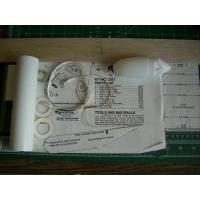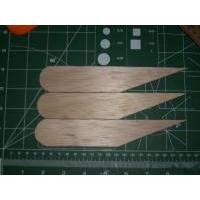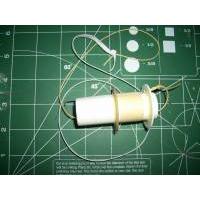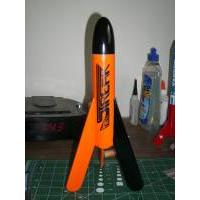| Construction Rating: | starstarstarstarstar |
| Flight Rating: | starstarstarstarstar |
| Overall Rating: | starstarstarstarstar |
| Published: | 2011-03-03 |
| Manufacturer: | Estes  |
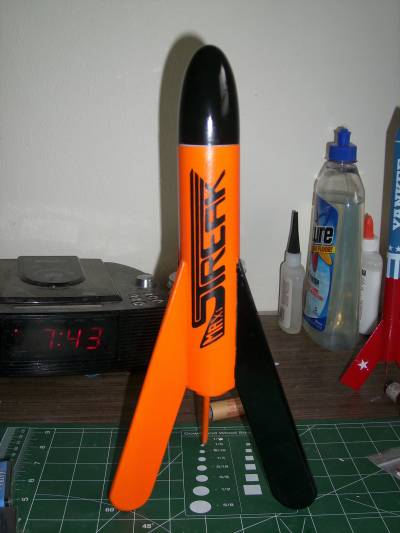 Brief
Brief
The Estes Maxi Streak #1837 ran from 1982 to 1984. It was rated as a sports flier and was a single-stage, low-power rocket. It was recovered using a 90" streamer. You can use a engine adapter to fly this rocket on 18mm engines.
Components
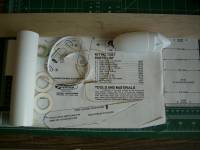 Here are the components used to assemble the rocket:
Here are the components used to assemble the rocket:
- Engine mount tube BT-50J 2.75"
- Engine hook EH-2 Standard
- Engine block AR-2050
- Two Adapter rings RA-2060
- Kevlar Thread 100# 12"
- Body tube BT-60FG 6.75"
- Shock cord SC-2 18"
- Launch lug LL-2A 2-3/8"
- Balsa wood sheet 3/16"
- Plastic nose cone PNC-60MS Big Bertha style.
- Streamer SM-1 2"x90"
- Decal sheet from Excelsior Rocketry
Construction
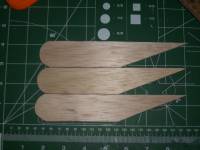 The first step was assembly of the motor mount. The modification I did was to attach the Kevlar thread to the top of the engine hook, cutting a small notch in the top of the adapter ring for thread to fit through and cutting another notch in the adapter ring for the engine hook to lift freely. After the engine mount had dried, I installed it into the main body tube, gluing it into place and tying the shock cord to the Kevlar thread.
The first step was assembly of the motor mount. The modification I did was to attach the Kevlar thread to the top of the engine hook, cutting a small notch in the top of the adapter ring for thread to fit through and cutting another notch in the adapter ring for the engine hook to lift freely. After the engine mount had dried, I installed it into the main body tube, gluing it into place and tying the shock cord to the Kevlar thread.
Next was tracing and cutting out the fins, sanding leading edge, and sanding round the bottom of the fins. Using the marking guide pattern sheet, I applied the lines for the fins and launch lug. I applied glue to root edge of the fins and attached them to the body tube and also the launch lug then set the parts aside to dry. I then applied glue to the fin joints and let it dry.
Finishing
I sanded the nose clone to get rid of the extra plastic and cleared the eyelet. I applied two light coats of primer and sanded the smooth then finished up with three light coats of gloss black spray paint.
To the the fins, I applied three coats of sanding sealer sanding in between coats. I applied two light coats of primer to the rocket without the nose cone attached. I sanded it smooth then taped of one fin and applied three light coats of gloss orange spray paint.
After letting it dry for a couple of days, I taped off the rest of the rocket, except for the one unpainted fin, and applied three light coats of gloss black spray paint.
One of the last things to do was to tie the shock cord to the nose cone, fold the streamer in half to find the middle, and attach it to the shock cord.
I applied the Excelsior Rocketry decal and let it dry. Finally, I applied Future Gloor finish to the decal.
Flight
The recommended motors for the Estes Maxi Streak are the Estes D11-9, D12-5, and D12-7.
I made the first two flights using a engine adapter and Estes B4-4 then B6-4 motors. Three flights were on Estes C11-5 motors. All five flights were straight and landed with no damage. On the C11-5, the rocket screamed off the pad.
Recovery
The rocket comes down nicely on the streamer - not too fast.
Summary
PROs: This is nice flier and easy to build. The Excelsior Rocketry decal looks really nice on the rocket.
CONs: Swept back fins can be damaged on recovery, that it hasn't been a problem yet.
Overall Rating: 5
 |
 |
Flights
 |
 |
